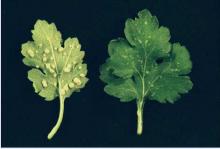See:
Chrysanthemum - Rust (Brown Rust)
Cause Puccinia horiana, a microcyclic rust. This federally quarantined disease was rarely reported until the early 1990s when several California nurseries reported problems. It has been found and eradicated in several nurseries in the greater Portland, OR area off and on since 1995 and in British Columbia since 2001. Usually it is found in nurseries that 'hold-over' mums from the previous growing season. The fungus can be systemic in the root crowns of some cultivars allowing overwintering in many areas. High humidity, free water, and moderate temperatures (63°F is optimum) favor the fungus. Teliospores are killed by 80% relative humidity for only 5 min. Telia may survive up to 8 weeks on dry leaves unless they are buried, in which case they last only 1 week. Spores produced in telia can be blown by the wind and reinfect chrysanthemum up to 0.5 mile away. Splashing water and human handling can also spread spores. Germ tubes, arising from basidiospores, penetrate the host epidermis directly without appressoria. No alternate host is known. Any green tissue of the plant can be infected, but younger leaves are most susceptible.
Florists', hardy, and garden chrysanthemums are highly susceptible. Variations in host range have been detected, which suggests two or more races of the fungus. The following cultivars were observed to have little damage from this disease: Albert Heijn (Royal and White), Finmark, Freedom, Hawaii, Helsinki, Kes, Majesty, Paso Doble, Statesman (also had little damage from several insect problems), Tiger, Tigerrag, and Westland (Winter and Yellow).
Symptoms Small, pale green to yellow spots develop on upper leaf surfaces. On the undersides, buff to pink pustules (telia) form. Pustules turn white with age (production of basidiospores) and eventually become necrotic late in fall. Portions of the leaf may fall out, giving a shothole or tattered appearance. Severe infections may result in premature defoliation. Early symptoms are similar to brown rust.
If you think you have this disease please call the USDA APHIS PPQ office in Portland, OR and/or the ODA Invasive species hotline (1-866-INVADER).
Cultural control
- Carefully inspect all cuttings and/or cut flowers coming into your operation. Imported plants should be isolated from any growing areas.
- Destroy all plants with known infections, including roots.
- Rake and destroy all fallen leaves or any other plant debris.
- Do not grow susceptible plants in the area for at least 8 weeks.
- Select resistant cultivars.
- Reduce humidity and avoid overhead irrigation. Keep leaves dry.
Chemical control Use to prevent infections if the disease has been found in the area. Alternate or tank-mix products from different groups that have different modes of action. Resistance in Europe has already developed to Group 3 and 11 fungicides.
- Armada 50 WDG at 3 to 9 oz/100 gal water. Do not use a silicone-based surfactant. Not for nursery or greenhouse use. Group 3 + 11 fungicide. 12-hr reentry.
- Banner MAXX at 8 to 12 fl oz/100 gal water may help. Group 3 fungicide. 12-hr reentry.
- Bonide Fung-onil Multi-purpose Fungicide at 2.25 teaspoons/gal water. Group M5 fungicide. H
- Broadform at 4 to 8 fl oz/100 gal water. Group 7 + 11 fungicide. 12-hr reentry.
- Daconil Weather Stik at 1.38 pints/100 gal water. Group M5 fungicide. 12-hr reentry.
- Eagle 20 EW at 8 fl oz/100 gal water. Group 3 fungicide. 24-hr reentry.
- Fame SC at 1 to 4 fl oz/100 gal water. Group 11 fungicide. 12-hr reentry.
- Heritage at 1 to 4 oz/100 gal water plus a non-silicone-based wetter sticker. Group 11 fungicide. 4-hr reentry.
- Insignia SC at 3 to 6 fl oz/100 gal water. Do not use with organosilicate-based adjuvants. Use preventively only. Group 11 fungicide. 12-hr reentry.
- Mancozeb-based products. Group M3 fungicides. 24-hr reentry.
- Fore 80 WP at 1.5 lb/100 gal water plus a spreader-sticker.
- Protect DF at 1 to 2 lb/100 gal water plus 2 to 4 oz spreader-sticker.
- Myclobutanil 20 EW T&O at 6 to 12 fl oz/100 gal water plus spreading agent. May observe a PGR effect. Group 3 fungicide. 24-hr reentry.
- Pageant at 6 to 12 oz/100 gal water. Do not use with organosilicone-based adjuvants. Group 7 + 11 fungicide. 12-hr reentry.
- Postiva at 10 to 28 fl oz/100 gal water. Group 3 + 7 fungicide. 12-hr reentry.
- ProStar 70 WG at 3 to 6 oz/100 gal water. Group 7 fungicide. 12-hr reentry.
- Spectracide Immunox Multi-Purpose Fungicide Spray Concentrate for Gardens at 1 fl oz/gal water. Group 3 fungicide. H
- Spectro 90 WDG at 1 to 2 lb/100 gal water. Group 1 + M5 fungicide. 12-hr reentry.
- Terraguard SC at 2 to 8 fl oz/100 gal water. Group 3 fungicide. 12-hr reentry.
- Tourney EZ at 1 to 4 oz/100 gal water. Group 3 fungicide. 12-hr reentry.
References Bonde, M.R., Murphy, C. A., Bauchan, G.R., Luster, D.G., Palmer, C.L., Nester, S.E., Revell, J.M., and Berner, D.K. 2015. Evidence for systemic infection by Puccinia horiana, causal agent of chrysanthemum white rust, in Chrysanthemum. Phytopathology 105:91-98.
Bonde, M.R., Peterson, G.L., Rizvi, S.A., and Smilanick, J.L. 1995. Myclobutanil as a curative agent for chrysanthemum white rust. Plant Disease 79:500-505.


